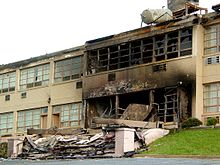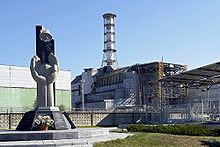- List of man-made disasters
-
Man-made disasters are disasters resulting from man-made hazards (threats having an element of human intent, negligence, or error; or involving a failure of a man-made system), as opposed to natural disasters resulting from natural hazards. Man-made hazards or disasters are sometimes referred to as anthropogenic.
Contents
Sociological hazards
Crime
Main article: CrimeCrime is to breach to rules or laws for which some governing authority (via mechanisms such as legal systems) can ultimately prescribe a conviction. Individual human societies may each define crime and crimes differently. While every crime violates the law, not every violation of the law counts as a crime; for example: breaches of contract and of other private law may rank as "offenses" or as "infractions". Modern societies generally regard crimes as offenses against the public or the state, distinguished from torts (offenses against private parties that can give rise to a civil cause of action).
In context, not all crimes provide man-made hazards.
Arson
Main article: ArsonArson is the criminal intent of setting a fire with intent to cause damage. The definition of arson was originally limited to setting fire to buildings, but was later expanded to include other objects, such as bridges, vehicles, and private property. Arson is the greatest cause of fires in data repositories. Sometimes, human-induced fires can be accidental: failing machinery such as a kitchen stove is a major cause of accidental fires.[1]
Civil disorder
Main articles: Civil disorder and RiotCivil disorder is a broad term that is typically used by law enforcement to describe forms of disturbance. Although civil disorder does not necessarily escalate to a disaster in all cases, the event may escalate into general chaos. Rioting has many causes, from antipathy over low minimum wages to racial segregation. Examples of well-known civil disorders and riots are the Poll Tax Riots in the United Kingdom in 1990; the 1992 Los Angeles riots in which 53 people died; the 2008 Greek riots after a 15-year-old boy was fatally shot by police; and the 2010 Thai political protests in Bangkok during which 91 people died.
Terrorism
Main articles: Terrorism and Asymmetric warfare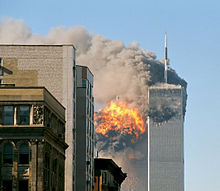 September 11 attacks, which are in multiple categories of manmade disaster: terrorist attack, air disaster, arson, and structural collapse
September 11 attacks, which are in multiple categories of manmade disaster: terrorist attack, air disaster, arson, and structural collapse
Terrorism is a controversial term with varied definitions. One definition means a violent action targeting civilians exclusively. Another definition is the use or threatened use of violence for the purpose of creating fear in order to achieve a political, religious, or ideological goal. Under the second definition, the targets of terrorist acts can be anyone, including civilians, government officials, military personnel, or people serving the interests of governments.
Definitions of terrorism may also vary geographically.In Australia, the Security Legislation Amendment (Terrorism) Act 2002, defines terrorism as "an action to advance a political, religious or ideological cause and with the intention of coercing the government or intimidating the public", while the United States Department of State operationally describes it as "premeditated, politically-motivated violence perpetrated against non-combatant targets by subnational groups or clandestine agents, usually intended to influence an audience".[2]
War
Main article: WarWar is conflict between relatively large groups of people, which involves physical force inflicted by the use of weapons. Warfare has destroyed entire cultures, countries, economies and inflicted great suffering on humanity. Other terms for war can include armed conflict, hostilities, and police action. Acts of war are normally excluded from insurance contracts and disaster planning.
Technological hazards
Industrial hazards
Industrial disasters occur in a commercial context, such as mining accidents. They often have an environmental impact. The Bhopal disaster is the world's worst industrial disaster to date, and the Chernobyl disaster is regarded the worst nuclear accident in history. Hazards may have longer-term and more dispersed effects, such as dioxin and DDT poisoning.
Structural collapse
 The 1940 Tacoma Narrows Bridge collapsing, in a frame from a 16mm Kodachrome motion picture film taken by Barney Elliott
The 1940 Tacoma Narrows Bridge collapsing, in a frame from a 16mm Kodachrome motion picture film taken by Barney Elliott
Structural collapses are often caused by engineering failures. Bridge failures may be caused in several ways, such as under-design (as in the Tay Bridge disaster), by corrosion attack (such as in the Silver Bridge collapse), or by aerodynamic flutter of the deck (as in Galloping Gertie, the original Tacoma Narrows Bridge). Failure of dams was not infrequent during the Victorian era, such as the Dale Dyke dam failure in Sheffield, England in the 1860s, causing the Great Sheffield Flood. Other failures include balcony collapses or building collapses such as that of the World Trade Center.
Power outage
Main article: Power outageA power outage is an interruption of normal sources of electrical power. Short-term power outages (up to a few hours) are common and have minor adverse effect, since most businesses and health facilities are prepared to deal with them. Extended power outages, however, can disrupt personal and business activities as well as medical and rescue services, leading to business losses and medical emergencies. Extended loss of power can lead to civil disorder, as in the New York City blackout of 1977. Only very rarely do power outages escalate to disaster proportions, however, they often accompany other types of disasters, such as hurricanes and floods, which hampers relief efforts.
Electromagnetic pulses and voltage spikes from whatever cause can also damage electricity infrastructure and electrical devices.
Recent notable power outages include the 2005 Java–Bali Blackout which affected 100 million people and the 2009 Brazil and Paraguay blackout which affected 60 million people.
Fire
 An active flame front of the Zaca Fire
An active flame front of the Zaca Fire See also Category: Fire disasters involving barricaded escape routes.
See also Category: Fire disasters involving barricaded escape routes.Bush fires, forest fires, and mine fires are generally started by lightning, but also by human negligence or arson. They can burn thousands of square kilometers. If a fire intensifies enough to produce its own winds and "weather", it will form into a firestorm. A good example of a mine fire is the one near Centralia, Pennsylvania. Started in 1962, it ruined the town and continues to burn today. Some of the biggest city-related fires are The Great Chicago Fire, The Peshtigo Fire (both of 1871) and the Great Fire of London in 1666.
Casualties resulting from fires, regardless of their source or initial cause, can be aggravated by inadequate emergency preparedness. Such hazards as a lack of accessible emergency exits, poorly marked escape routes, or improperly maintained fire extinguishers or sprinkler systems may result in many more deaths and injuries than might occur with such protections.
Hazardous materials
Main article: Dangerous goodsRadiation contamination
When nuclear weapons are detonated or nuclear containment systems are otherwise compromised, airborne radioactive particles (nuclear fallout) can scatter and irradiate large areas. Not only is it deadly, but it also has a long-term effect on the next generation for those who are contaminated. Ionizing radiation is hazardous to living things, and in such a case much of the affected area could be unsafe for human habitation. During World War II, United States troops dropped atomic bombs on the Japanese cities of Hiroshima and Nagasaki. As a result, the radiation fallout contaminated the cities' water supplies, food sources, and half of the populations of each city were stricken with disease. The Soviet republics of Ukraine and Belarus are part of a scenario like this after a reactor at the Chernobyl nuclear power plant suffered a meltdown in 1986. To this day, several small towns and the city of Chernobyl remain abandoned and uninhabitable due to fallout. In the 1970s, a similar threat scared millions of Americans when a failure occurred at the Three Mile Island Nuclear Power Plant in Pennsylvania. The incident was fortunately resolved, and the area retained little contamination.
A number of military accidents involving nuclear weapons have also resulted in radioactive contamination, for example the 1966 Palomares B-52 crash and the 1968 Thule Air Base B-52 crash.
CBRNs
Main article: CBRNCBRN is a catch-all initialism for chemical, biological, radiological, and nuclear. The term is used to describe a non-conventional terror threat that, if used by a nation, would be considered use of a weapon of mass destruction. This term is used primarily in the United Kingdom. Planning for the possibility of a CBRN event may be appropriate for certain high-risk or high-value facilities and governments. Examples include Saddam Hussein's Halabja poison gas attack, the Sarin gas attack on the Tokyo subway and the preceding test runs in Matsumoto, Japan 100 kilometers outside of Tokyo,[3] and Lord Amherst giving smallpox laden blankets to Native Americans.[4]
Transportation
Aviation
Main article: Air disasters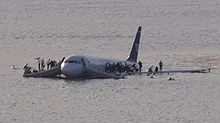 The ditching of US Airways Flight 1549 was a well-publicised incident in which all on board survived
The ditching of US Airways Flight 1549 was a well-publicised incident in which all on board survived
An aviation incident is an occurrence other than an accident, associated with the operation of an aircraft, which affects or could affect the safety of operations, passengers, or pilots. The category of the vehicle can range from a helicopter, an airliner, or a space shuttle. The world's worst airliner disaster is the Tenerife crash of 1977, when miscommunications between and amongst air traffic control and an aircrew caused two fully laden jets to collide on the runway, killing 583 people.
Rail
Main article: Rail disasters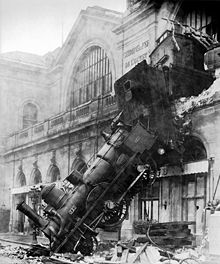 Granville-Paris Express wreck at Gare Montparnasse on 22 October 1895
Granville-Paris Express wreck at Gare Montparnasse on 22 October 1895
A railroad disaster is an occurrence associated with the operation of a passenger train which results in substantial loss of life. Usually accidents with freight (goods) trains are not considered disasters, unless they cause substantial loss of life or property. One of the most devastating rail disasters occurred in 2004 in Sri Lanka when 1,700 people died in the Queen of the Sea train disaster. Other notable rail disasters are the 1989 Ufa accident in Russia which killed 574, and the 1917 Modane train accident in France which killed 540.
See also the list of train accidents by death toll.
Road
Traffic collisions are the leading cause of death, and road-based pollution creates a substantial health hazard, especially in major conurbations. The greenhouse effect of road transport is a significant fraction of the anthropogenic warming effect, and the rapid consumption of fossil fuel accelerates the Hubbard peak.
Space
Main article: Space accidents and incidents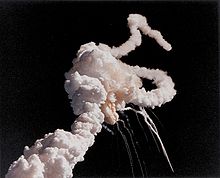 Disintegration of the Space Shuttle Challenger
Disintegration of the Space Shuttle Challenger
Space travel presents significant hazards, mostly to the direct participants (astronauts or cosmonauts and ground support personnel), but also carry the potential of disaster to the public at large. Accidents related to space travel have killed 22 astronauts and cosmonauts, and a larger number of people on the ground.
Accidents can occur on the ground during launch, preparation, or in flight, due to equipment malfunction or the naturally hostile environment of space itself. An additional risk is posed by (unmanned) low-orbiting satellites whose orbits eventually decay due to friction with the extremely thin atmosphere. If they are large enough, massive pieces travelling at great speed can fall to the Earth before burning up, with the potential to do damage.
The worst space disaster to date occurred on February 15, 1996 in Sichuan, China, when a Long March 3B rocket, carrying the Intelsat 708 telecommunications satellite, suffered a guidance system failure two seconds after liftoff and crashed into a nearby village. The Chinese government officially reported six deaths and 57 injuries, but some U.S. estimates run as high as 200 deaths.
The second worst disaster was the Nedelin catastrophe which occurred in the Soviet Union on October 24, 1960, when an R-16 intercontinental ballistic missile exploded on the launch pad, killing around 120 (best estimate) military ground support personnel. The Soviet government refused to acknowledge the incident until 1989, then claiming only 78 deaths.
One of the worst manned space accidents involved the Space Shuttle Challenger which disintegrated in 1986, claiming all seven lives on board. The shuttle disintegrated 73 seconds after taking off from the launch pad in Cape Canaveral, Florida.
Another example is the Space Shuttle Columbia, which disintegrated during a landing attempt over Texas in 2003, with a loss of all seven astronauts on board. The debris field extended from New Mexico to Mississippi.
A Partial list of shipwrecks Ships can sink, capsize or crash in disasters. One well known sinking was that of the titanic which hit a iceberg and sank.
Costs
Some man-made disasters have been particularly notable for the high costs associated with responding to and recovering from them, including:
- Deepwater Horizon oil spill, 2010: Between $60 and $100 billion.[5]
- September 11 attacks, 2001: $20.7 billion;
- Chernobyl disaster, 1986: $15 billion estimated cost of direct loss. It is estimated that the damages could accumulate to €235 billion for Ukraine and €201 billion for Belarus in the thirty years following the accident;
- Three Mile Island, 1979: $1 billion;
- Exxon Valdez oil spill, 1989: The clean-up of oil spill cost an estimated $2.5 billion; recovery for settlements, $1.1 billion; and the economical loss (fisheries, tourism, etc.) suffered due to the damage to the Alaskan ecosystem was estimated at $2.8 billion;
- AZF chemical plant explosion, 2001: €1.8 billion[6]
The costs of disasters varies considerably depending on a range of factors, such as the geographical location where they occur. When a disaster occurs in a densely populated area in a wealthy country, the financial damage might be huge, but when a comparable disaster occurs in a densely populated area in a poorer country, the actual financial damage might relatively small, in part due to a lack of insurance. For example, the 2004 Indian Ocean earthquake and tsunami (although obviously not man-made) with a death toll of over 230,000 people, cost a 'mere' $15 billion,[7] whereas the Deepwater Horizon oil spill, in which 11 people died, the damages were six-fold.
See also
See also Category: Man-made disasters.- List of wars and anthropogenic disasters by death toll
- Existential threat
- Survivalism
References
- ^ [1]
- ^ http://www.official-documents.gov.uk/document/cm70/7052/7052.pdf
- ^ http://www.fas.org/irp/congress/1995_rpt/aum/part05.htm
- ^ http://www.nativeweb.org/pages/legal/amherst/lord_jeff.html
- ^ http://www.rff.org/Documents/RFF-BCK-Cohen-DHCosts.pdf
- ^ http://www.foeeurope.org/activities/Nuclear/pdf/2007/Face_your_demons.pdf
- ^ http://sschonhardt.com/2011/03/24/costs-beyond-measure
Disasters Overview Disasters NaturalList of environmental disasters • Tornado • Drought • Mudslide • Flood • Tropical cyclone • Earthquake • Historic fires • Forest fires • Impact eventTransportIndustrialStructural failures and collapses • Bridge • Dam • Nuclear • Nuclear and radiation by death toll • Civilian radiation • Civilian nuclear • Military nuclear • Oil spills • Levee • Mast and tower • Infrastructure • SpaceHealthMan-madeWars and anthropogenic disasters • Battles and other violent events • Military • Wars • Terrorist incidents • Riots • MassacresCountermeasures Media Feature films • DocumentariesOrganizations Global Risk Forum GRF Davos • International Association of Emergency Managers • International Disaster and Risk Conference • Disaster Accountability Project • International Disaster Emergency ServicePortal: DisastersCategories:- Hazards
- Man-made disasters
Wikimedia Foundation. 2010.

